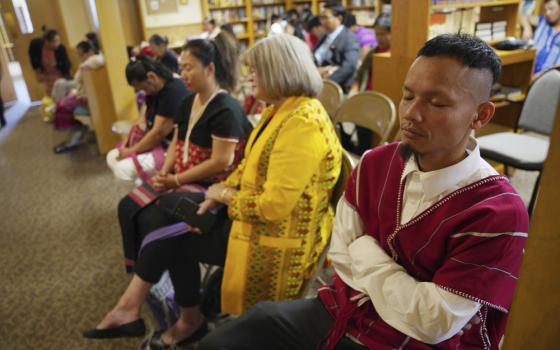Today is the feast of St. Casimir, patron of Lithuania and Poland, 1458-1484.
In the famous Carlo Dolci painting, he is holding a paper inscribed with the words of his favorite hymn: Omni die dic Mariae, which we know as Daily, Daily Sing to Mary. Casimir was buried with a copy of the hymn.
"He was the grandson of Wladislaus II Jagiello, King of Poland, who introduced Christianity into Lithuania, and the second son of King Casimir IV and Queen Elizabeth, an Austrian princess, the daughter of Albert II, Emperor of Germany and King of Bohemia and Hungary."
Casimir became his father's heir apparent when his older brother became King of Bohemia.
"When Casimir was approximately 16 or 17 years old, he began traveling with his father through their realm, attending diets, meetings of the State Council, and receptions of representatives of foreign countries, in order to gain experience in affairs of state. When he reached the age of 22, his father assigned him an active part in the government, including administrative duties, responsibilities in the judicial system and in military and financial matters. In 1481-83 he represented his father in Poland when he remained in Lithuania. During that time the young Casimir strengthened the financial condition of the state; repaid debts on mortgaged estates; curbed banditry in the provinces; improved the tone of the royal palace by removing unsuitable courtiers; and strengthened relations with the Holy See. While performing his difficult duties and leading a strict ascetical life, he impaired his health and contracted tuberculosis."
--Catholic Church in Lithuania
He died at the age of 25.
"After making interviews with living witnesses and scrutiny of miracles, the papal nuncio, Zacharias Ferrerri, a Benedictine monk and bishop, set out the results he had collected in the first biography of St. Casimir, Vita Beati Casimiri, 1521. It related that Casimir matured into a person of strong character, successfully able to resist the lure of a life of luxury and earthly pleasures, he used to wear a hairshirt under his royal robes, the book described his acts of mortification, his sleeping on the bare ground, his prayers at the door of a closed church, his alms to the poor, widows and orphans and his meditations on the Passion of Christ. Among his numerous virtues his justice and self-discipline are also attested by other sources. It is known that he was particularly determined to preserve perfect chastity by refusing to marry and adhering to the principle Malo mori quam foedari (I prefer to die than to be defiled)."
His relics are enshrined in the Chapel of St. Casimir in Vilnius Cathedral.
Lithuanians cherish St. Casimir and celebrate his feast day with a fair called a Kaziuko muge.
"The most typical Kaziuko muge merchandise was Vilniaus verbos. These are various dried flowers and grasses braided together into typical Lithuanian designs and tied to short sticks; they are taken to church on Palm Sunday and later used to decorate the home.
"Another typical Kaziuko muge product or muginukas, was a heart- shaped honey cookie, decorated with colored sugar flowers, zig-zags, dots and birds. Popular men's and women's names were written on the cookies. People bought and gave them to selected loved ones. It was a custom to bring some back for anyone who had to remain home." (Recipes at the link.)
For more images of St. Casimir, click here.



